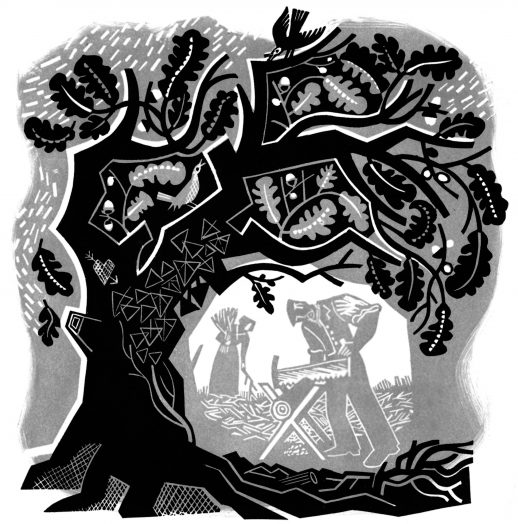The Long, Long Life of Trees by Fiona Stafford
(Yale, paperback, 288 pages. Out now and available here.)
Illustration by Clare Curtis
Review by Emma Warren
Some animals have a highly developed sense of smell. Others have incredible vision. Humans? We have a powerful sense of symbolism. That’s the takeaway from academic and author Fiona Stafford’s richly detailed cultural appreciation of trees.
Her book, now published in paperback, explains our relationship with seventeen different species in unapologetically anthropomorphic style, starting with the yew and fetching up at the beginning of the alphabet with the apple. Her unpicking of the stories humans create around trees makes for a generous and enlightening read. It’s a good thing that she didn’t try and write the reverse, though, as their relationships with us could probably be condensed into a couple of very short lines: “Really, again?”
Trees will have been some of the largest living things to greet the waves of migrants who arrived as the Ice Age glaciers receded, making it unsurprising that trees loom so large in our collective imagination. Stafford’s narrative cleverly suggests that we build our tree-stories on a number of blocks: the locations and traditional uses of certain species; the human attributes they suggest through their size and shape; and the way they’ve been used for propaganda. These are rich seams and the first alone provides acres of interesting context: yews, for example, gained their reputational connection to the afterlife because they were often found in graveyards – although Stafford soberly points out this was a sensible location given their toxicity and subsequent risk to grazing animals.
It’s her treatment of tree stories in relation to political power grabs that provides a new way of looking at these supersized plants. Kings and politicians have long manipulated our susceptibility to trees as avatars for qualities that the people using them might not actually possess. She describes the way that Henry VII used the hawthorn to solidify his power and his claim to the throne, not least with insignia that featured a crown above that tree. “[It] drew on the powerful symbolism of the Crown of Thorns, underlining the divinity of the monarch and the promise of a new, better reign,” she writes. “The hawthorn’s prickly reputation also reminded people of Britain that this new king was ready to defend his claim against all comers.” It’s not a hard stretch to see why the Conservative Party stand behind the reassuring solidity of the oak, despite — y’know — everything.
Stafford is happy to fell a few myths about exceptionalist identity, breezily mentioning that oaks are also the national trees of Bulgaria, Croatia, Cyprus, Estonia, France, Germany, Latvia, Lithuania, Moldova, Poland, and Romania, Serbia and the United States of America. Oak was appropriated by Germans to show national strength (planted in war cemeteries and ‘commandeered by Bismarck as an emblem of unity’) and by Basque separatists. You have to wonder why we believe so strongly in our own stories and yet have such little awareness of those believed by our neighbours, but hey, that’s us.
Stafford empathises. Her writing, which follows her BBC Radio 3 programme ‘The Meaning of Trees’, understands why people might need to believe that local trees could offer help or support. In the chapter on the deliciously solitary rowan, Stafford writes about bark being used as a prophylactic against the risk presented by witches. “Suspicions about the theft of milk from inside a cow’s udder is not too different from being worrying about petrol being siphoned out of the car…There is nothing new about the fear of nasty neighbours or the faint sense of hidden threat lurking behind faces we see every day and yet do not really know. In communities where there were no nursery alarms, or emergency services, the desire for security is easy to understand.”
The way we weave trees into our human storylines is, to use her lovely phrase, a ‘cascade of references’. It’s just a very tangled and contradictory cascade. Sycamore is routinely described as ‘non-native’, despite been here for 500 years, when horse chestnuts arrived around the same time from the Balkans – and what could be more English than conkers, eh?
The Long, Long Life of Trees is stuffed full of neat descriptions and facts. Hollywood’s name is based on mistaken taxonomy and should actually be ‘Toyonwood’; pines are ‘peachy-patchy’; hawthorns were used as needles for early turntables. On top of the neatly packaged info, it’s replete with visual splendour: gorgeous, angular woodcuts, judiciously selected photography and bespoke illustration.
The biggest story though, comes in the form of asides. The ash is being wiped out by dieback. Oaks? They’re threatened by disease. Horse Chestnuts are dying countrywide because of the double threat of Leaf Miner Beetles and Bleeding Canker. Looking at it with glass half empty eyes, it seems that a scary portion of the book is written with an eye on the past tense. These passages contain the suggestion that everyday trees may require description to future generations, as with the generational divide between people who knew elms and those of us who grew up after Dutch Elm Disease. The pine, however — our oldest species — offers a less gloomy perspective. Stafford describes some powerfully adaptive strains found in post-Chernobyl Ukraine. “They demonstrated an astonishing capacity to survive the radioactive winter,’ she writes, ‘by apparently adapting their DNA to the new environment and so ensuring gradual recovery’. Survival, it seems, is hardwired – like our need for stories.
*
The Long, Long Life of Trees is available here in the Caught by the River shop, priced £10.99. You can read an extract here.
